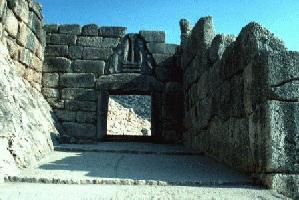

|
|
Background
Aeschylus: 525 B.C. - 455 B.C.: the earliest of the Big Three Tragedians grew up in the times of the tyrant slaying and the reforms of Cleisthenes fought at Marathon and Salamis against the Persians lived to see the institution of the radical democracy of Ephialtes assoc. with the glittering age in which Athenian democracy came to assert its strength against formidable enemies both barbarous and Greek Oresteia =Agamemnon + Libation Bearers + Eumenides: a "trilogy", that is, three plays performed one after the other as a sort of superplay: 458 B.C. Agamemnon: king returns from Troy and is struck down in his bathtub by his wife Choephori = Libation Bearers: Ag's son, Orestes, grown to manhood, takes revenge on his mother and her lover, Aegisthus Eumenides: Orestes, tormented by the Erinyes, the avenging goddesses, for having murdered his mother, is absolved from his blood guilt by an Athenian jury court set up esp. for this purpose by Athena, the patron goddess of the city. At first this verdict only arouses the anger of the Erinyes, but Athena uses flattery to convince them to make their residence henceforth in Athens, transformed into "Eumenides" = "the kindly ones", that is, kindly, beneficent goddesses The story of the Trojan War (Greeks and Trojans), for which Agamemnon was the supreme commander on the Greek side The sacrifice of Agamemnon's daughter, Iphigenia Ten year siege of Troy The story of Agamemnon's return from the War Personalities in the "House of Atreus" Tantalus: served up his son to the gods, to show up the gods' omniscience Thyestes and Atreus: Thyestes slept with Atreus' wife, Atreus served up Thyestes' children to Thyestes Agamemnon and Aegisthus: Agamemnon the son of Atreus, Aegisthus the son of Thyestes Clytaemnestra (=Clytaemestra, Klytaimestra) and Cassandra: Cassandra the daughter of Priam (king of Troy), a captive from the war and Agamemnon's concubine; also, famously, a prophetess doomed to have no one believe her\ Children of Clytaemnestra and Agamemnon: Orestes, Electra For a genealogy of the House of Atreus, see Agamemnon summary (at end) Mycene (the important palace center that is the "capital" of Agamemnon's domain): the entrance to the city is the "lion's gate" (below), and the royal line is strongly associated with lions


The "cinematic" function of poetry in drama
Agamemnon & Iphigenia: 201-247 (compulsion to sacrifice?) Fall of Troy: 326-351 (victory: a joy or a horror? cycle of revenge) Soldier's life: 542-559 (Hell of the siege: Agamemnon's leadership) Helen 403-424, 733-738, 1483-89 (dream-like things, or desires urged on by a dream, lead to the killing of men) Atreus and Thyestes: 1095-97, 1189-1198, 1526-1533 Such images are not mere background, but are central images raising central questions: (1) what led to the murder (near causes, ancient causes)? (2) on whose side does justice lie? (3) will the cycle of killing ever end? Humans learn through suffering. pathei mathos.But if one killing / punishment leads to the next, where is the learning?
Poetry, drama, and the construction
of meaning
Example 1: lions
- 140-41: Artemis, "kind to the ravening lion's tender, helpless cubs"
- 714ff. The lion cub: who is it?
- 813ff: lion of Argos lapping the blood of Trojan kings
- 1232ff: Aigisthos, "strengthless lion" rolling in his master's bed
- 1272: Clytaemnestra as the woman-lioness, who goes to bed with the wolf, when her proud lion-king goes away
- Lion image should be a proud one, image of the power and stability of the Mycenaean kingdom & of Mycene's king-- but here emphasis on bestiality, blood, cruelty.
- Since lion = Zeus-cherished king = instrument of justice in the society, the perversion of the lion symbol becomes an image of moral chaos in the society
Example 2: Light / Darkness
- "Justice shines in sooty hovels" (761); "Justice-bringing day"
- Several times characters will salute the day, or the light, or Justice itself, as though all was finally vindicated and the slate of ancient crime and suffering is wiped clean: but (like the coming of night upon day) that brightness never lasts, and is almost immediately assaulted with images of shadow and darkness
- Herald: 498-9, cf. 509-515
- (Agamememnon: 795-797: salutes the "just gods"-- doesn't come through in Fagles translation)
- Clytaemnestra: 1458-1464: rightful revenge: Aig. = light, stability
- Aigisthos: 1605: Brilliant day for vengeance!
Example 3: Male / Female
- Clytaemnestra a woman with the heart and speech of a man (355, "spoken like a man"; she is hard, 275); Aegisthus is a man with a strengthless heart
- Spring rain: Clytaemnestra's perversion of the ultimate image of fertility: lines 1407ff
- Will Justice be associated with
- Zeus of the upper air/Male/Heaven/Light/Reason, OR
- Earth-Zeus of the underworld/Female/Dark/Blood revenge/Irrational
What is justice? What is the nature of justice? What sort of justice is right? By linking this to the male / female divide, Aeschylus brings these sets of questions, surreally, to the point of cosmic conflict: so, in the Eumenides, Apollo (Male/Olympian/Light/Reason) debates the nature of what is right with the Erinyes = Furies (Female/Earth/Darkness/Irrational blood revenge) before, of all things, a human court of justice, overseen by Athena (female but without a mother, allied with the male). Question of the rationality of justice: why do we condemn murderers to death? In what sense is that "right"?
Questions to ponder:1.Who is the hero of the Agamemnon? In what sense a hero?
2.Why exactly does Clytaemnestra kill Agamemnon, and are there problems with the justice of this
killing? Collect specific passages to support your claims.
People and places to know:
Agamemnon Clytaemnestra Iphigenia Cassandra Aegisthus Mycene Orestes Electra